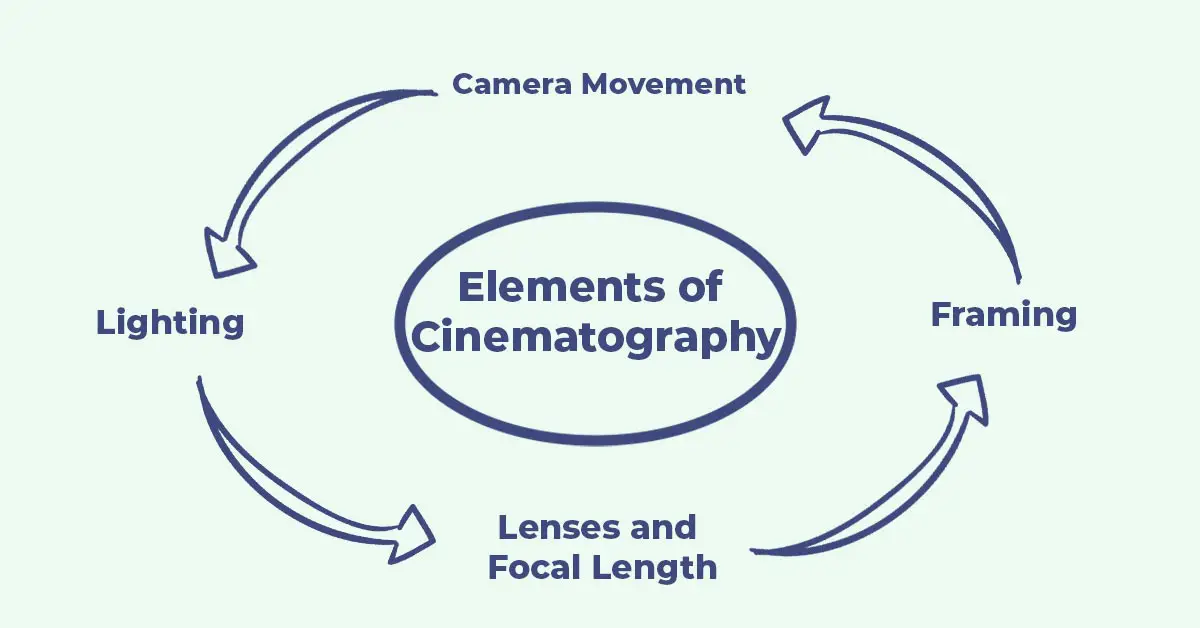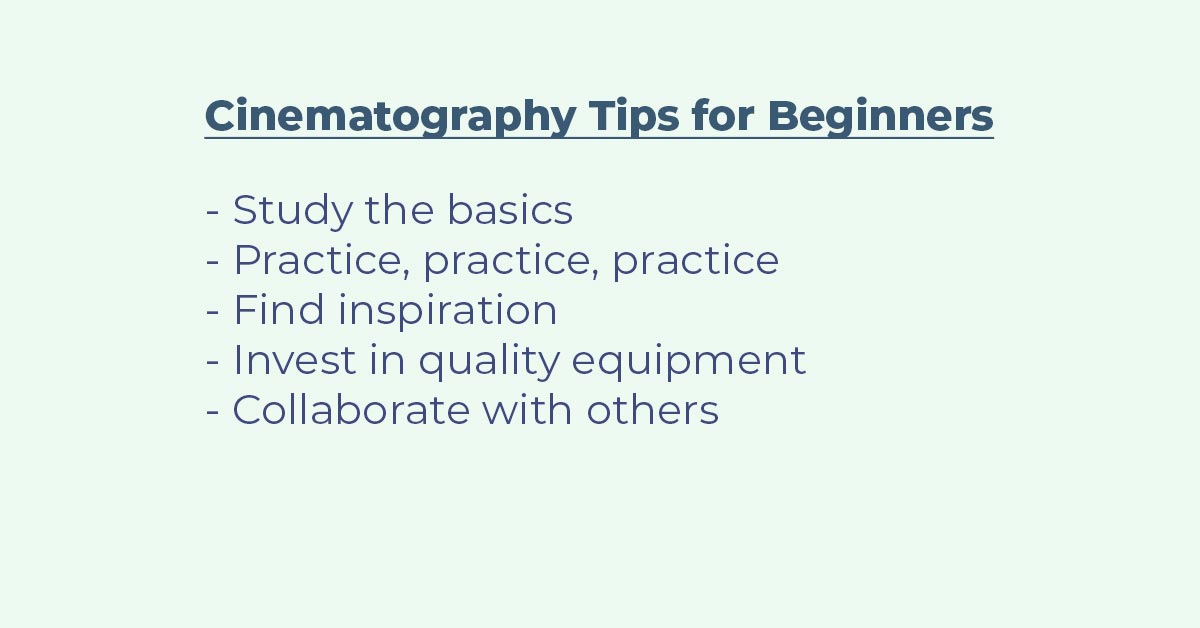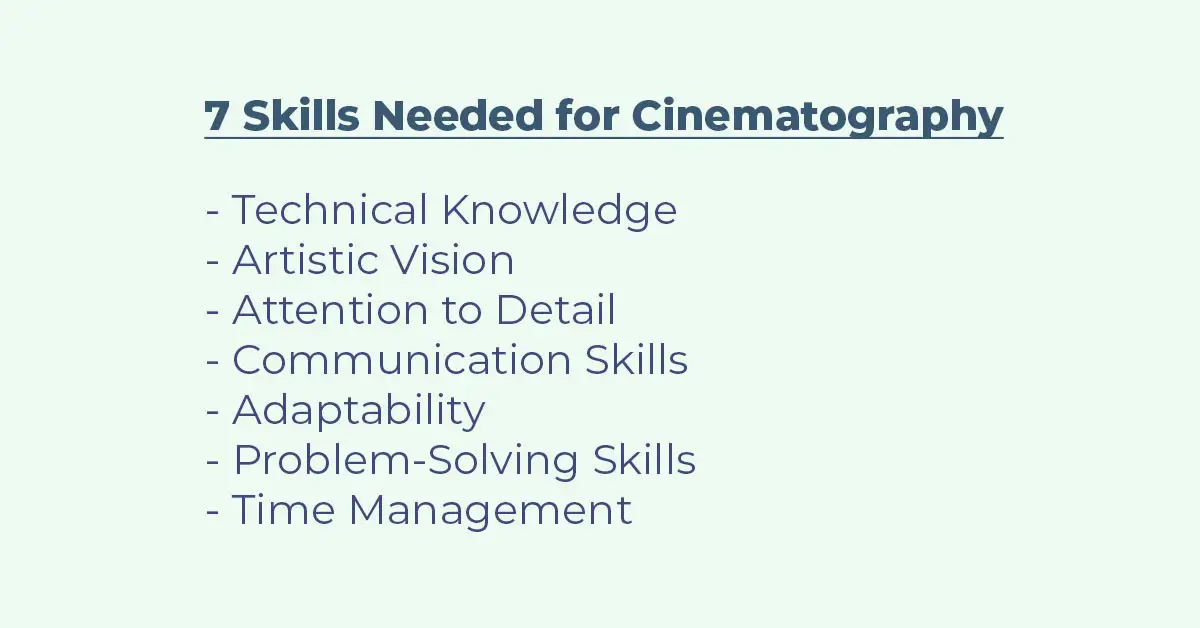Before we get into the topic of the day, let’s first understand – What is cinematography? Cinematography is the art and technique of capturing images and videos for films, TV shows, and other forms of audiovisual media. It encompasses aspects such as lighting, camera work, color grading, and lens selection.
When it comes to the process of making a film, it plays a crucial role in shaping the look, feel, and atmosphere of a film. Cinematography is really helpful in conveying the story, setting the mood, and creating a visual impact on the audience.
In this article, we will look at the various aspects of cinematography, the responsibilities of a cinematographer, and the evolution of this field over the years. We will also discuss some tips and tricks purposely for those new to this field, the six elements for cinematic composition among other things. Join us as we explore the world of cinematography basics.
What Is Cinematography?
As mentioned earlier in the intro cinematography can be defined as the art and technique of capturing and creating images and videos for films, TV shows, and other forms of audiovisual media. It involves a combination of various elements, including lighting, camera work, color grading, and lens selection, to create visually stunning and impactful scenes.
The whole process dates back to the late 19th century with the invention of motion picture cameras. The industry has seen change over time, incorporating new methods and technologies to produce breath-taking movies. Today, cinematographers use a wide range of tools and equipment to bring their visions to life.
Cinematography is an integral part of filmmaking that plays a crucial role in shaping the look, feel, and atmosphere of a film. It helps convey the story, set the mood, and create a visual impact on the audience. Usually, a cinematographer works closely with the director and other members of the film crew to bring the script to life visually.
What Are the Five Elements of Cinematography?
The five elements of cinematography are:

- Lighting: This refers to the use of light to illuminate and enhance the visual elements in a scene.In filmmaking, light can be used to create mood, establish the time of day, and highlight or draw attention to a given action taking place inside the frame.
- Framing: This is the arrangement of objects and characters within the frame, including the use of space, color, and other visual elements. This is usually done to create visual interest and meaning.
- Camera Movement: This refers to the movement of the camera, such as tracking shots, panning shots, and dolly shots, to create visual interest and convey motion. The movement of the camera helps to add dynamism at the same time creating suspense while conveying a character’s emotions.
- Lenses and Focal Length: The choice of lenses can affect the look and feel of the image hence creating different visual effects, for instance, wide-angle lenses being used to create a sense of grandeur or telephoto lenses being used to create a more intimate feeling.
- Camera placement – This is basically the angle at which the camera is positioned relative to the subject, it can be categorized as high, low, dutch and eye-level. Usually, cinematographers use this to convey power dynamics, perspective, and emotion.
Each of these elements plays a crucial role in the process of telling the story visually and for you to be successful as a cinematographer you must carefully consider them in order to effectively convey the story and engage the audience.
Why Is Cinematography Important to Filmmaking?
Cinematography plays a great role in achieving the following things in the process of making a film:
- Conveying the story: Through the use of different lighting techniques, camera angles, and other visual elements, the cinematographer can convey the emotions and atmosphere of each scene, bringing the story to life for the audience hence playing a crucial role in conveying the story of a film.
- Setting the mood: The use of light, color, and different camera angles in cinematography helps to set the mood and atmosphere of a film therefore creating a deeper connection with the audience. To evoke different emotions, such as fear, excitement, or sadness, a cinematographer can utilize these tools hence making the film more impactful and memorable.
- Creating a visual impact: Cinematography is a powerful tool for creating a visual impact on the audience. For instance, a well-crafted shot like a dollying close-up, can leave a lasting impression on the eyes of the audience revealing the emotional state of the characters in the film.
- Enhancing the film experience: By working closely with the director and other members of the film crew, the cinematographer helps to enhance the overall film experience for the audience in creating a visually stunning and emotionally impactful film.
Now that you have a clear understanding of how cinematography is important to the filmmaking process in the next section we are going to look at the aspects of cinematography.
What Are the Different Aspects of Cinematography?
The process of creating and capturing videos and images for film involves the following: Lighting, Camera work, Color grading, Lens selection, Special effects and Sound design. In this section we are going to look at each of these individually and try to understand what they all entail
Lighting
From a filmmaking point of view lighting is a critical aspect of cinematography, as it sets the mood, creates depth, and helps to bring the story to life. Cinematographers use a range of lighting techniques, including key lighting, backlighting, and fill lighting, to achieve the desired look and feel of each scene.
Camera Work
This involves a couple of things including the selection and use of cameras, lenses, and other equipment to capture images and footage. This usually includes choosing the right camera angles, movement, and shot composition to tell the story effectively.
Color Grading
Color grading is the process of adjusting the colors and tones of the footage to achieve a desired look and mood through the use of some special Non – Linear Editing software (NLEs) like Adobe Premiere Pro, Final Cut Pro or Davinci Resolve. This is a critical aspect of cinematography, as it can greatly impact the overall look and feel of a film.
Lens Selection
The choice of lenses used in the process of making a film is an important aspect of cinematography. This choice affects the look and feel of each shot, for instance, a wide-angle lens can be used for sweeping vistas – creating that feeling of loneliness in your characters and the use of a telephoto lens mainly for close-ups can create that intimate feeling between your audience and the subjects in frame by revealing the emotions experienced by your subjects.
Special Effects
Special effects are used in cinematography to create visual effects (VFX) that cannot be captured through live-action filming. This can include everything from computer-generated imagery (CGI) to practical effects, such as explosions and fire. This is very important in the process of creating a film since it brings about that feeling of realism in the eyes of the audience.
Sound Design
While not traditionally considered as part of cinematography, sound design is an integral aspect of filmmaking. A sound designer works with the cinematographer to create the soundscape for a film, including dialogue, music, and sound effects. This is generally important to the process because it immerses your audience into the world of the film making them experience what the subjects in the film experienced during the actual shoot.
These 6 aspects of cinematography will mark the end of this section. In the next section we will be covering the roles and responsibilities of a cinematographer.
What Are the Responsibilities of a Cinematographer?
From the Pre-Production stage of a film all the way to the Post-Production stage, a cinematographer is responsible for the following duties:
- Conceptualizing the Visual Style: A cinematographer works with the director to determine the visual style and look of a film. They collaborate to create a visual plan that will effectively tell the story and evoke the intended emotions.
- Setting up Shots: The cinematographer is responsible for setting up and executing each shot. This process usually involves choosing camera angles, movements, lens selection, and lighting.
- Collaborating with the Production Team: A cinematographer works closely with other members of the production team, including the director, gaffer, and sound designer, to ensure that all aspects of the film come together seamlessly.
- Maintaining and Keeping track of camera equipment: A cinematographer must be familiar with the latest equipment and technology, and must also be responsible for maintaining and troubleshooting equipment issues on set.
- Overseeing Post-Production: A cinematographer is involved in post-production where their role is to oversee the color grading and visual effects to ensure that the final product meets the intended visual style.
What Are Some Cinematography Tips for Those New to the Field?
If you were to start out your journey as a cinematographer today, what are some of the practical tips you would do? Some of you may ask this question. Well, there is no straight answer to this question but here are some tips that we’ve found to work for almost everyone depending on where they’re in their journey.
- Study the basics: Start by learning the basics of cinematography, including composition, lighting, and shot types.
- Practice, practice, practice: As you may all know, Practice makes what?… Well Practice makes progress. The best way to improve your cinematography skills is by practicing and experimenting with different techniques and styles because when you do that continually you will eventually find something that works for you.
- Find inspiration: Finding inspiration can come in different forms. For instance, you can draw inspiration from studying what makes your favorite films great in terms of the cinematography aspect of it or by looking at successful cinematographers in the industry with the hope of picking up a familiar pattern in their line of work so as to develop your own unique style and voice.

- Invest in quality equipment: I’m pretty sure most of you have heard this statement before: “Gear doesn’t matter” . Well, to some point this statement is true and false at the same time. Let me explain, this statement is true when you are starting out in your career as a cinematographer/ filmmaker but when you advance, investing in quality equipment, such as cameras and lighting gear, will help you create better results and bring your vision to life.
- Collaborate with others: One thing that most filmmakers tend to underestimate is the power that comes with working with other filmmakers. You see, collaborating with other filmmakers, including directors, writers, and actors, can help you develop your skills and build your network.
With that out of the way, you should always remember that everyday is a new day to reinvent yourself. Continuously learn and grow your skills by attending workshops, taking online courses, and seeking feedback from others in the industry.
What Are the 6 Elements of Cinematic Composition?
First of all, before we get to understand these 6 elements, what is Cinematic Composition? Well, it refers to the visual arrangement of elements within the frame of a movie or film.
Some of the elements that help create cinematic composition include:
- Line: The use of lines in the frame, whether they are real lines, such as those created by buildings and other objects, or implied lines, such as those created by the position of characters or objects.
- Shape: The use of geometric shapes, such as circles, triangles, and squares, to create visual interest and convey meaning.
- Form: The three-dimensional aspects of objects within the frame, including texture, volume, and mass.
- Space: The way that the elements in the frame are positioned relative to each other, including the use of foreground, middle ground, and background.
- Texture: The surface quality of objects within the frame, including rough, smooth, and textured elements.
- Color: The use of color to create visual interest and reinforce the mood and meaning of the film.
With the help of these key elements cinematographers can create a harmonious and impactful visual composition hence in the process creating visual interest, conveying meaning, and reinforcing the mood and themes of the film.
What Skills Are Needed for Cinematography?
In order to be successful as a cinematographer, here are some unique skill sets you’ll need to posses:
Technical Knowledge
Personally, I believe this is the most obvious skill you need to have. So what exactly do we mean by technical knowledge? Well, this term has different definitions but when it comes to the world of cinematography: it is having a thorough understanding of the technical aspects of cinematography like understanding the ins and outs of camera and lighting equipment, lenses, and software.
Artistic Vision
What do I exactly mean by this,you may ask. Well, this is the ability to create visually stunning images that convey the emotions and themes of the story. As a cinematographer this skill will come in handy as you will not only be capturing averaging looking images for your films. The best way to actually improve on this as a cinematographer is to check other films and also the different forms of art like painting.
Attention to Detail
If there is one thing that cinematography boils down to – It is details. When it comes to lighting, camera angles, and other visual elements, cinematography thrives on meticulous attention to detail. As a cinematographer you should be keen on the effect a small change in the height, quality or distance of your lighting has on any given scene you’re shooting.

Communication Skills
Filmmaking is a collective task, by now I believe you already know that, right? In order to be successful as a cinematographer you need to have strong communication skills so as to effectively collaborate with the director, production crew, and actors and also share your ideas on how to improve the film.
Adaptability
The ability to adapt to changing conditions, such as weather, lighting, and unexpected technical difficulties is a must have skill as a cinematographer. In almost all filmmaking projects, a full filming plan is usually laid down where every department anticipates what is to happen but sometimes that doesn’t usually happen. As a cinematographer it is very important for you to have the ability to adapt to any changes that may occur which you hadn’t factored in in your plan.
Problem-Solving Skills
In most cases the whole filmmaking process is not a “straight line” a lot of issues usually arise along the filming journey, for instance a camera overheating, or one of the crucial members in your team not turning up for your shoot. As a cinematographer the ability to quickly and creatively solve some of these problems that may arise during filming will really come in handy.
Time Management
You see, when it comes to the process of making a film literally, “Time is money,” What do I mean by that? Well most shooting locations are usually charged on hourly rates. Having strong time management skills to effectively balance the technical and creative aspects of cinematography is usually a plus to a cinematographer.
Conclusion
In conclusion, understanding cinematography basics is a very crucial aspect of filmmaking as it will help a lot in the process of bringing a story to life on screen.
As a cinematographer, it’s important to have a strong understanding of the history and evolution of the cinematography world, as well as the skills needed to create visually stunning and emotionally impactful films. With all the tips provided in this article, I’m pretty sure you’re well on your way to mastering the basics of cinematography and taking your filmmaking to the next level.
If you liked this article, I’m pretty sure you’ll also enjoy reading our other article on the differences between a Cinematographer and a Director. Check it out here!


